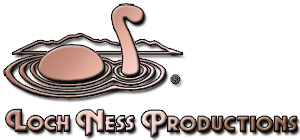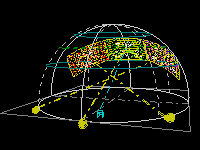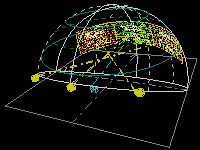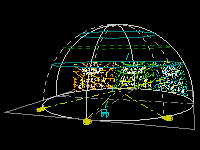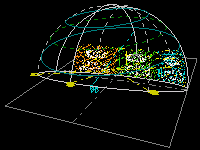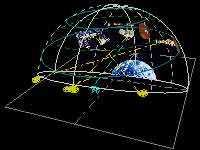| In the production studio: Computer with CD-ROM drive Image processing software Output device |
| In the theater 1. At least three dissolve-pair slide projectors in L-C-R array |
| 2. Horizon panorama (or all-sky) projector system, 2-deep in some screens. |
| 3. A capable planetarium star projector with Sun and Moon |
| 4. The ability to point out objects on cue |
| Recommended: Zoom-slew Moving pinpoint |
| NOT used: Video |
The Cowboy Astronomer Equipment Requirements
With more than 75 images to show, The Cowboy Astronomer is not the most visually complex program we offer, but it still requires a well-equipped planetarium theater to present. We've provided this page to help you determine if your planetarium has the necessary equipment to present The Cowboy Astronomer.
The show soundtrack is recorded on CD, so you'll need a CD player to play the disc, even if it's just to copy the audio to another medium, such as multi-track tape or hard drive.
The show's still images are recorded on data CD, so you'll need the resources (computer, image processing software, output devices) to transform the digital images into whatever form your theater uses to project. For classic (slide-projector-based) planetaria, that will mean making 35mm slides.
1. At least three dissolve-pair slide projectors in Left-Center-Right array
This is a screen format familiar to long-time Loch Ness Productions customers.
Many of the scenes in our shows are illustrated with three images, which are introduced in sequential order: Left, then Center, then Right. After all three are up, they often "wipe" off in the same order.
In this show, the left and right screens don't necessarily have to be dissolvers, but for timing, there are instances in which dissolve pairs may come in handy.
There are two lap dissolve sequences — a supernova and a stellar formation sequence.
We say "at least three" dissolve screens, but the more, the merrier. And you'll need to make use of several "auxiliary" or single-shot projectors, to overlay constellation outlines, for example, or images on top of horizon pans.
2. Horizon panorama and/or all-sky projector system
Over half the show package's images are horizon scenes — to be projected at the base of the dome, beneath the starry sky.
There are eight multi-panel images in the show — which, using 20th-century terms, can be translated as horizon panoramas. In the digital age, what may be a 3-panel pan in one theater may be a 2- or 4-panel pan in another, or a pan can be remapped to an all-sky. Nonetheless, you'll need that calibrated set of projectors which project on the horizon, commonly known as a panorama system.
Ideally, your pan system will be 2-deep, so you could keep the 360° surround Plains pan in one set (we return to it several times throughout the show), and crossfade to the 3-panel partial pans in the other set. If you only have one set of pan projectors, you'll need to make or purchase at least three additional copies of the 12-panel pan, so you won't have to be cycling backward and forward during the run of the show.
And the pan projectors should be independently accessible, so you can position secondary images in the B set on top of the A set. We should see the lights of the pickup truck (slides) "driving" on the road in the panorama, and the pickup actually parked on the pan. You'll need to position the Indian maidens on top of the mountain — on the horizon.
The other pans are in a 9:2 format ratio — what might otherwise be called "3-panel partial pans". These are intended to span approximately 90 degrees on the horizon.
All this is in addition to the dissolvers, which project up in the sky, of course. There are times you'll use both together, such as when a pan is on the horizon, and spacecraft on orbit above it.
3. A capable planetarium star projector with Sun and Moon.
The Cowboy Astronomer uses the planetarium star projector extensively during the show. Diurnal motion to show stars rotating around Polaris is required, as well as for making the Sun rise above the Medicine Wheel. The Moon is mentioned in one scene, and it should be positioned to be reflecting off the water in the Plains panorama.
We also roll from Winter through Spring to late Summer to catch Pegasus and Andromeda in the East.
4. The ability to point out objects on cue
With this show, it's absolutely essential for various objects in the sky to be pointed out in time with the narration. There are at least 15 pointer cues to hit. With a handheld pointer, this will take hours of practice. It's unlikely that the "occasional" or untrained show presenter can effectively hit cue points on time just by reading along in the script. For example, there are several times when our narrator says, "Look over here..." Unless the pointer is exactly in position at the right time — not early, not late — it's just plain unacceptably wrong. A programmable zoom/slew as a pointer could be put through its paces in this show.
Objects pointed out in the sky include:
- Big Dipper (bowl, arc of handle, Pointer stars)
- Polaris
- Orion (belt stars, Nebula)
- Betelgeuse
- Sirius
- Pleiades
- Crab Nebula location
- Baseball Diamond of Pegasus (home plate, first base, second base, third base, pitcher, catcher, umpire, dugout, first base foul line, all-star outfield)
- Cygnus
- Deneb
- Milky Way
Recommended: Zoom-slew, Moving pinpoint
While non-moving slides can illustrate most of the scenes, the show will benefit from having some images, such as the Hubble Space Telescope and satellite slowly drift across the starfield. Capable programmable zoom/slews can also perform pointer functions.
The narrator says, "Look at that little point of light moving slowly across the sky... that's a satellite." In theory, you could use a planet from your star projector, but a separate moving pinpoint will work a lot better.
NOT used: Video
We use no moving video with the show, intentionally. This is a program designed for the pacing of still imagery. The visual style of the show is non-dynamic slides. To have inserted just one or two video clips would have been very jarring and out-of-context with the remainder of the show. In other words, why would there be only one or two scenes that feature full motion animation, when the rest of the show doesn't have any?
